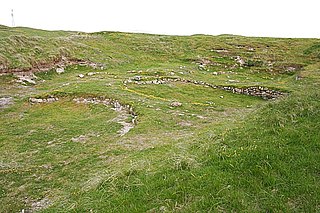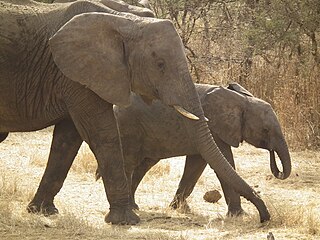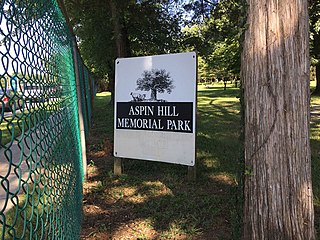
A cemetery, burial ground, gravesite, graveyard, or a green space called a memorial park, is a place where the remains of dead people are buried or otherwise interred. The word cemetery implies that the land is specifically designated as a burial ground and originally applied to the Roman catacombs. The term graveyard is often used interchangeably with cemetery, but a graveyard primarily refers to a burial ground within a churchyard.

Hyde Park is a 350-acre (140 ha), historic Grade I-listed urban park in Westminster, Greater London. A Royal Park, it is the largest of the parks and green spaces that form a chain from Kensington Palace through Kensington Gardens and Hyde Park, via Hyde Park Corner and Green Park, past Buckingham Palace to St James's Park. Hyde Park is divided by the Serpentine and the Long Water lakes.
Repton is a village and civil parish in the South Derbyshire district of Derbyshire, England, located on the edge of the River Trent floodplain, about 5 miles (8 km) north of Swadlincote. The population taken at the 2001 census was 2,707, increasing to 2,867 at the 2011 census. Repton is close to the county boundary with neighbouring Staffordshire and about 5 miles (8 km) northeast of Burton upon Trent.

A pet cemetery is a cemetery for pets. Although the veneration and burial of beloved pets has been practiced since ancient times, burial grounds reserved specifically for animals were not common until the late 19th century.

Cladh Hallan is an archaeological site on the island of South Uist in the Outer Hebrides in Scotland. It is significant as the only place in Great Britain where prehistoric mummies have been found. Excavations were carried out there between 1988 and 2002, which indicate the site was occupied from 2000 BC.

Ban Non Wat is a village in Thailand, in the Non Sung district, Nakhon Ratchasima Province, located near the small city of Phimai. It has been the subject of excavation since 2002. The cultural sequence encompasses 11 prehistoric phases, which include 640 burials. The site is associated with consistent occupation, and in modern-day Ban Non Wat the occupied village is located closer to the Mun River.

Rosa Bonheur Memorial Park is a pet cemetery located in Elkridge, Maryland, USA. The cemetery was established in 1935, and was actively operated until 2002. Approximately 8,000 animals and humans are buried in the cemetery's 11+1⁄2 acres, which is large enough to accommodate about 24,000 pets.

Doggerland was an area of land in Northern Europe, now submerged beneath the southern North Sea. This region was repeatedly exposed at various times during the Pleistocene epoch due to the lowering of sea levels during glacial periods, though the term "Doggerland" is generally specifically used for this region during the Late Pleistocene and Early Holocene. During the early Holocene, the exposed land area of Doggerland stretched across the region between what is now the east coast of Great Britain, the Netherlands, the western coast of Germany and the Danish peninsula of Jutland. Between 10,000 and 7,000 years ago, Doggerland was inundated by rising sea levels, disintegrating initially into a series of low-lying islands before submerging completely. The impact of the tsunami generated by the Storegga underwater landslide c. 8200 years ago on Doggerland is controversial. The flooded land is known as the Dogger Littoral.

Ing'ombe Ilede is an archaeological site located on a hill near the confluence of the Zambezi and Lusitu rivers, near the town of Siavonga, in Zambia. Ing'ombe Ilede, meaning "a sleeping cow", received its name from a local baobab tree that is partially lying on the ground and resembles a sleeping cow from a distance. The site is thought to have been a small commercial state around the 16th century whose chief item of trade was salt. Ing'ombe Ilede received various goods from the hinterland of south-central Africa, such as, copper, slaves, gold and ivory. These items were exchanged with glass beads, cloth, cowrie shells from the Indian Ocean trade. The status of Ing'ombe Ilede as a trading center that connected different places in south-central Africa has made it a very important archaeological site in the region.

The Villa of the Quintilii is a monumental ancient Roman villa beyond the fifth milestone along the Via Appia Antica just outside the traditional boundaries of Rome, Italy. It was built by the rich and cultured Quintilii brothers Sextus Quintilius Valerius Maximus and Sextus Quintilius Condianus.

Ilford Animal Cemetery is an animal cemetery in Ilford in London, England, United Kingdom that contains over three thousand burials. It was founded in the 1920s and is operated by the People's Dispensary for Sick Animals. The cemetery was closed to new burials in the 1960s and gradually became neglected and overgrown before a £50,000 grant from the National Lottery led to its reopening.
Susan was a Pembroke Corgi dog owned by Queen Elizabeth II that was given to her on her eighteenth birthday. Following the dog's death in 1959, the Queen personally designed a headstone for her grave at Sandringham House. Susan was the first of a long line of Corgis and Dorgis owned by the Queen, all of them descended from Susan. The dogs often accompanied the Queen in her public appearances, and thus came to feature prominently in her public image.

Timothy Insoll is a British archaeologist and Africanist and Islamic Studies scholar. Since 2016 he has been Al-Qasimi Professor of African and Islamic Archaeology at the University of Exeter. He is also founder and director of the Centre for Islamic Archaeology. Previously he was at the Department of Archaeology at the University of Manchester (1999–2016).

Swaga Swaga Game Reserve is a Tanzanian game reserve located in northwest Dodoma Region, that gives refuge to elephants and other vulnerable animals. It is located 50.6 miles from the city of Babati.
The archaeological site of Al-Ashoosh is a third-millennium BC settlement located 70 km (43 mi) south of Dubai in the United Arab Emirates (UAE). It is an important example of inland desert occupation in the period following the Holocene Climatic Optimum period and of human occupation in the Rub' al Khali during the Umm Al Nar period. Archaeologists believe Al-Ashoosh was a seasonal settlement occupied by a hunter/pastoral community, probably occupying structures of perishable materials, during the second half of the third millennium BC. It is thought the water table would have been higher, supporting inland settlement in what is now a plain and arid site with a brackish well. The site was used for the production of stone tools.
Koji Mizoguchi is a Japanese archaeologist and a professor of social archaeology in the Graduate School of Social and Cultural Studies at Kyushu University. He studies the comparative emergence of societies in Europe and Japan and has a particular interest in the history of archaeology. He currently serving as the sixth president of the World Archaeological Congress, serves as director of the Advanced Asian Archaeology Research Center at Kyushu University, and is an elected fellow of the London Society of Antiquaries. He has been involved in numerous archaeological projects, and is currently a co-director of the project ‘Beneath Hay Bluff: prehistoric south-west Herefordshire, c.4000-1500 BC.'

Hosn Niha is an archaeological site in Lebanon composed of some temples and buildings in the outskirts of the village of Niha, that hold significant archaeological value.

Aspin Hill Memorial Park, also known as Aspin Hill Pet Cemetery, is a pet cemetery located in Aspen Hill, Maryland, at the intersection of Georgia Avenue and Aspen Hill Road, 7.5 miles (12.1 km) north of Washington, D.C. The cemetery contains more than 50,000 pet burials, and more than 50 human burials. Aspin Hill Memorial Park is a designated individual site on Montgomery County, Maryland's Master Plan for Preservation.
Louise Steel is Professor of Near Eastern Archaeology at the University of Wales Trinity St David. Her research focuses on the prehistoric Mediterranean world, in particular Cyprus and the Eastern Mediterranean, as well as on themes of materiality and the human body. She conducts fieldwork in Cyprus at the Late Bronze Age site of Arediou Vouppes.
The Jarigole pillar site is one of the megalithic communal cemetery sites in Lake Turkana Basin in Northern Kenya associated with the Pastoral Neolithic period. The site is located on the eastern shores of Lake Turkana in the southeastern edge of the Sibiloi National Park. Situated in a recessional beach which is 70 m (230 ft) above the 1973 lake level, the site includes oval platforms >1,000 m2 (11,000 sq ft) with a circular mound, and 28 basalt pillars each weighing about 200 kg (440 lb) and moved over a distance of 2 km (1.2 mi) from the site. The site is believed to have been constructed by the first wave of ancient herders who migrated to the region down from the Sahara around 5,000 years ago, a period marked by rapid climatic, economic and social change.
















